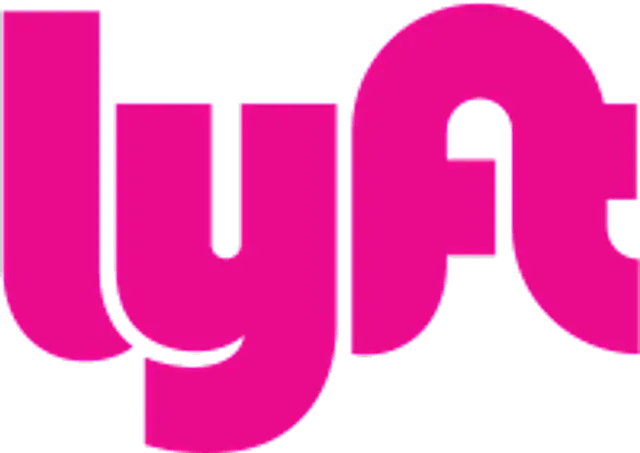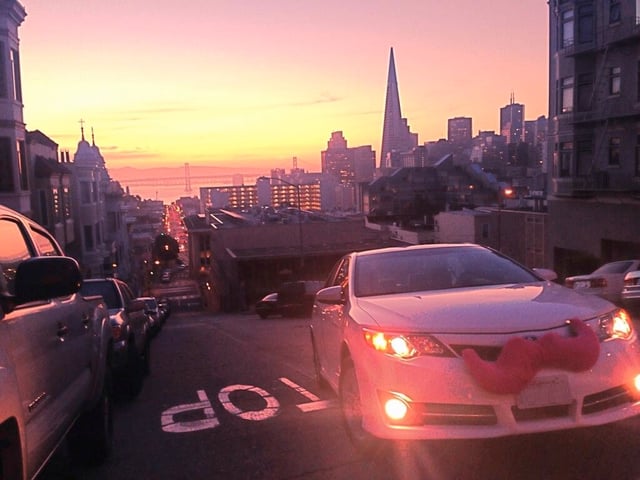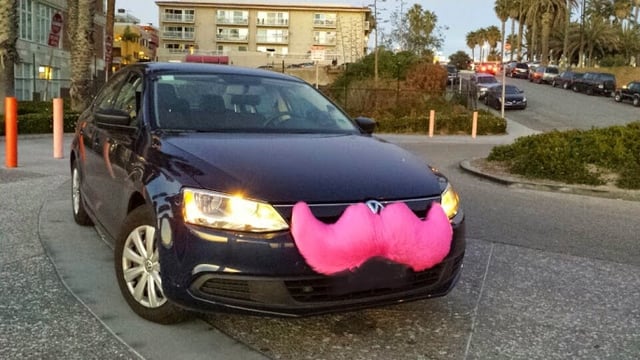Lyft

Lyft

| Public | |
| Traded as | |
| Industry | Transportation network company |
| Founded | June 9, 2012(asZimride) |
| Founders | Logan GreenJohn Zimmer |
| Headquarters | |
| United States,Canada | |
| Logan Green,CEOJohn Zimmer,PresidentJon McNeill,COOBrian Roberts,CFO | |
| Revenue | |
| Owner | Rakuten(11%)General Motors(6.6%)Fidelity Investments(6.5%)Andreessen Horowitz(5.3%)CapitalG(4.4%) |
| 4,854 (2018) | |
| Subsidiaries | Motivate |
| Website | |
| Footnotes / references[1] | |

Lyft's distinctive pink mustache was the first branding the company used until 2015 when it switched to a smaller, glowing magenta mustache that sits on a driver's dashboard.
Lyft, Inc. is a transportation network company (TNC) based in San Francisco, California and operating in 640 cities in the United States and 9 cities in Canada.[2] It develops, markets, and operates the Lyft mobile app, offering car rides, scooters, and a bicycle-sharing system.
Lyft is the second-largest TNC with a 28% market share in the United States, according to Second Measure.[3]
Most jurisdictions regulate TNCs and TNCs are banned from operating in some jurisdictions.
For more information, see Legality of transportation network companies by jurisdiction.
| Public | |
| Traded as | |
| Industry | Transportation network company |
| Founded | June 9, 2012(asZimride) |
| Founders | Logan GreenJohn Zimmer |
| Headquarters | |
| United States,Canada | |
| Logan Green,CEOJohn Zimmer,PresidentJon McNeill,COOBrian Roberts,CFO | |
| Revenue | |
| Owner | Rakuten(11%)General Motors(6.6%)Fidelity Investments(6.5%)Andreessen Horowitz(5.3%)CapitalG(4.4%) |
| 4,854 (2018) | |
| Subsidiaries | Motivate |
| Website | |
| Footnotes / references[1] | |
Product overview
Riders must download the Lyft mobile app to their iOS or Android-based phone, sign up, enter a valid phone number, and enter a valid form of payment (either a credit card, or link to an Apple Pay, Google Wallet, or PayPal account).[4][5] Once the trip is completed, funds are debited from the funding source.[6]
Car rides
Passengers can then request a ride from a nearby driver.
Once confirmed, the app shows the driver's name, ratings by past passengers, and photos of the driver and car.[7] Drivers and passengers can add personal information to their profiles about their hometown, music preferences, and other details to encourage drivers and passengers to converse during the ride.[8] After the ride is over, the rider is given the opportunity to provide a tip to the driver, which is also billed to the rider's payment method.[9]
Lyft offers five types of rides within the app:[10]
Shared Ride, which is not available in all cities, is the cheapest option and will match passengers with other riders if they are going in the same direction.[11]
Lyft is the basic and most popular offering that matches passengers with nearby drivers.
Lyft XL matches passengers with a vehicle that can seat at least six passengers.[12]
Lux matches passengers with a luxury vehicle that seats at least four passengers.[13]
Lux Black matches passengers with a luxury black exterior vehicle ride that seats at least four passengers.[13]
Lux Black XL matches passengers with a black exterior luxury car that seats up to six (i.e.: SUVs with highly rated drivers).[13]
Scooters
Lyft scooters cost US$1 to unlock and 15 cents per minute to ride.[14]
Driver requirements

Lyft drivers can decorate the interior of their vehicles to a certain extent.
All drivers undergo background checks including Department of Motor Vehicles, sex offender registries in the United States, and personnel-type criminal background checks. The criminal background check goes back seven years and includes national and county-level databases, as well as national sex offender registries.[15]
Drivers must be 21 years or older and have had a driver's license for more than one year.[15]
Government data requests
In 2017, Lyft received a 5/5 rating from the Electronic Frontier Foundation on how it handles government data requests.[16]
Ratings
After a ride is completed, drivers and passengers are given the opportunity to rate each other on a scale of one to five stars.[17] Any driver averaging a low rating by a passenger will not be matched with that passenger again.[15] Lyft does not allow passengers to know their rating.[18] The ratings establish the reputations of both drivers and passengers within the network.[19]
Insurance
Although Lyft drivers are classified as independent contractors, Lyft also insures each driver with a US$1 million commercial liability policy that is primary to a driver's personal policy. Additional coverage includes:[20]
Contingent comprehensive and collision coverage up to $50,000 with a $2,500 deductible. It applies from the time a driver accepts a ride request until the time the ride is ended in the app.
Contingent liability coverage up to $50,000 per person/$100,000 per accident/$25,000 property damage.
It applies from the time when a driver flips into driver mode until the driver accepts a ride request.
Uninsured/underinsured motorist coverage that comply with local regulations and/or state laws.
It applies from the time a driver accepts a ride request in the app until the time the ride is ended in the app.
History

A Lyft vehicle in Santa Monica, California, with the original grill-stache branding, since retired
Green had the inspiration for Zimride after sharing rides from the University of California, Santa Barbara campus to visit his girlfriend in Los Angeles. He had used Craigslist’s ride boards but wanted to eliminate the anxiety of not knowing the passenger or driver. When Facebook opened its API to third-party developers, Green said he thought "Here’s the missing ingredient."[23] Zimride linked drivers and passengers through the Facebook Connect application.[24] By using Facebook profile information, student drivers and passengers could learn about each other.[25] Zimride eventually became the largest carpool company in the United States.[26][27] Green was introduced to John Zimmer through a mutual friend and the pair initially met on Facebook. The company name came from the country Zimbabwe, where, during a trip in 2005, Green observed locals sharing minivan taxis.[28][29][30] Zimride launched at Cornell University, where, after six months, the service had signed up 20% of the campus.[31][32]
In July 2013, Lyft sold Zimride to Enterprise Holdings, the parent company of Enterprise Rent-A-Car, to enable the company to focus exclusively on the growth of Lyft.[35]
Whereas Zimride was focused on college campuses, Lyft launched as a TNC for shorter trips within cities.[25]
In January 2015, Lyft introduced a small, glowing plastic dashboard mustache it called a "glowstache" as an alternative to the large fuzzy mustaches on the front of cars.
The transition was to help overcome the resistance of some riders to arrive at destinations, such as business meetings, in a car with a giant mustache.[39]
In 2013, San Francisco Mayor Ed Lee proclaimed July 13 as Lyft Day.[42]
In April 2014, Lyft launched in 24 new U.S. cities in 24 hours, bringing its total to 60 U.S. cities.[43]
In April 2014, Lyft hired two lobbying firms, TwinLogic Strategies and Jochum Shore & Trossevin, to address the regulatory barriers and opposition it had received since its launch.[44]
Due to regulatory hurdles in New York City, the company altered its business model when establishing Lyft on the East Coast of the United States. Lyft’s launch in New York City occurred on the evening of July 25, 2014 and, in accordance with the Taxi and Limousine Commission (TLC) and the approval of the Manhattan Supreme Court, only drivers registered with the TLC were permitted to drive Lyft-branded vehicles in New York City.[45]
In August 2014, the company introduced a shared ride concept, which provides cheaper fares.[46]
In September 2015, Lyft announced a relocation of its customer service operations to Nashville and mentioned that a full relocation would be possible in the future from San Francisco.[47]
In December 2015, Lyft became the first TNC allowed to pick up passengers at Los Angeles International Airport.[48]
In May 2016, Lyft began offering a service to let clients schedule rides up to 24-hours in advance.[49]
In January 2017, the company announced its 160 millionth ride.[52]
In January 2017, Lyft announced it would add 100 U.S. cities, bringing its total to 300 U.S. cities served.[53]
In July 2017, the company announced that the Walt Disney World Resort "Minnie Van" service will be powered by Lyft. Users staying at select Walt Disney World Resort hotels are given the option to hail a "Minnie Van" via the Lyft app. A Minnie Van, a Chevrolet Traverse with Minnie Mouse inspired exterior theming, driven by a Walt Disney World Cast Member can take guests to and from any destination within the Walt Disney World Resort for a flat fee of $20 per ride. Lyft Founder John Zimmer said of the partnership "Playing a part in a family’s experience at the most magical place on earth is a dream come true."[55]
In December 2018, Lyft launched additional scooter fleets in Arlington County, Virginia, Atlanta, Austin, Texas, Los Angeles, Nashville, Tennessee, San Diego, Santa Monica, California and Washington, D.C..
In July 2019, the company's Lyft Entertainment division received an Emmy nomination for its co-production of Billy on the Street.[65]
On July 19, 2019, Lyft added real time public transport and subway information for New York City, amidst battles with the city.[66]
Unwanted text messages
Self-driving car research
As early as 2012, Green wanted to pitch investors on self-driving cars as part of Lyft's future offering.
Green envisioned a few big networks of self-driving cars, similar to AT&T and Verizon.[69]
In January 2016, Lyft announced an autonomous car partnership with General Motors.[70] On May 5, 2016, Lyft and General Motors announced, as part of their partnership, that they planned to begin testing self-driving cars within the next year. They were considering using a self-driving Chevrolet Bolt for this purpose.[71]
On June 6, 2017, Lyft announced a new partnership with Boston-based autonomous self-driving car start-up NuTonomy with the aim of eventually putting thousands of autonomous, on-demand vehicles on the road.[72]
In March 2018, Lyft announced a partnership with GoMentum Station to test its self-driving technology, furthering the company's efforts toward making transportation safer and more accessible.[75]
On March 14, 2018, Lyft partnered with the largest auto part suppliers in North America, Magna International, with the motive to co-fund, develop, and manufacture autonomous vehicle systems which will help to produce self driving technology that will be available to all car manufacturers.[76]
In October 2018, Lyft acquired Blue Vision Labs, a London-based augmented reality startup, for an initial $72 million price. This expertise is expected to help autonomous cars to extract useful information from street-level images.[79][80]
Criticism
Criticism by the taxi industry
The taxi industry has claimed that TNCs skirt regulations that apply to passenger transport and TNCs are therefore illegal taxicab operations. This has resulted in additional regulations imposed on TNCs and, in some jurisdictions, certain TNCs are banned from operating.[81]
In New York City, use of TNCs has reduced the value of taxi medallions, transferable permits or licenses authorizing the holder to pick up passengers for hire. After soaring in value after the Great Recession due to their perceived safety, New York City taxi medallions were again trading for around $170,000 each in 2018. Annual rental rates were $30,000. A couple of credit unions that lent money secured by medallions suffered from bank failure.[82]
Classification of drivers as independent contractors
Unless otherwise required by law, TNC drivers are independent contractors and not employees. This designation may affect taxation, work hours, and overtime benefits and lawsuits have been filed by drivers alleging that they are entitled to the rights and remedies of being considered "employees" under employment law.[83] In response, TNCs say they provide "flexible and independent jobs" for drivers.[84]
In O'Connor v. Uber Technologies, a lawsuit filed in the United States District Court for the Northern District of California on August 16, 2013, Uber drivers pleaded that according to the California Labor Code they should be classified as employees and receive reimbursement of business expenses such as gas and vehicle maintenance costs. In March 2019, Uber agreed to pay $20 million to settle the case.[85]
On October 28, 2016, in the case of Aslam v Uber BV, the Central London Employment tribunal ruled that Uber drivers are "workers", rather than self-employed individuals, and are entitled to the minimum wage under the National Minimum Wage Act 1998, paid holiday, and other normal worker entitlements.[86] Two Uber drivers had brought the test case to the employment tribunal with the assistance of the GMB Union, on behalf of a group of drivers in London. Uber appealed the decision.[87] In December 2018, Uber lost an appeal of the case at the Court of Appeal, but was granted permission to appeal to the Supreme Court of the United Kingdom.[88]
In March 2018, the Federal Department of Economic Affairs, Education and Research of Switzerland, gave the legal opinion that under the conditions that bind drivers to Uber that they should be classified as employees.[89]
In April 2018, the California Supreme Court ruled in Dynamex Operations v. Superior Court that document delivery company Dynamex has misclassified its delivery drivers as independent contractors rather than employees.[90][91] This ultimately led to California passing Assembly Bill 5 on September 11, 2019, which would require many jobs, to be classified as employees, with the according minimum wage protections and unemployment benefits, beginning in 2020.[73][93][94] Uber and Lyft both pledged to keep drivers classified as contractors, saying they could meet the requirements of the new test, and both pledged $30 million on a 2020 ballot initiative against AB 5.[95]
Driver criticism of compensation
Drivers have complained that in some cases, after expenses, they earn less than minimum wage.
As a result, in some jurisdictions, such as New York City, drivers are guaranteed a minimum wage.
The New York City minimum wage was set at $26.51 before expenses or $17.22 after expenses in 2019, and an analysis by the NYC Taxi and Limousine Commission revealed that 85% of drivers made less than the minimum wage prior to the law.[96]
Dynamic pricing
TNCs use dynamic pricing models; prices for the same route vary based on the supply and demand for rides at the time the ride is requested.[97] When rides are in high demand in a certain area and there are not enough drivers in such area, fares increase to get more drivers to that area.[98] The rate quoted to the rider reflects such dynamic pricing.[99]
TNCs were criticized for extreme surcharges during emergencies such as Hurricane Sandy,[100] the 2014 Sydney hostage crisis,[101] and the June 2017 London Bridge attack,[102] especially when taxis offered to transport riders for free; however, in many cases, the surcharges were refunded by the TNCs and TNCs later agreed to either not charge surcharges, or in some cases, offer free rides, during certain emergencies.
Increased traffic congestion
TNCs have been criticized for increasing traffic congestion in New York City and San Francisco.[103][73] A report published by Schaller Consulting in July 2018 showed that, as a result of TNCs, traffic congestion increased both cities, which already had comprehensive public transport systems in place.[105][106] A main reason was that a large number of people, who would otherwise have used public transport, shifted to services offered by transportation network companies.
Reduced usage of public transportation
Studies have shown that TNCs have led to a reduction in use of public transportation.[107]
Lack of wheelchair accessible vans
In some areas, TNCs are required by law to have a certain amount of wheelchair accessible vans (WAVs) on the road at any given time. This can be a difficult requirement for TNCs to meet because TNCs don't provide vehicles and most drivers do not own a WAV, causing a shortage.[108]
Drivers using their phones while driving
When a customer makes a pick-up request, a driver is notified via mobile app and is provided the customer's location. The driver has approximately 15 seconds to tap the phone to accept the request. In many jurisdictions, tapping a phone while driving is against the law as it could result in distracted driving.[109]
See also
Uber
Transportation network company
Collaborative consumption
Microtransit
Mobility as a service